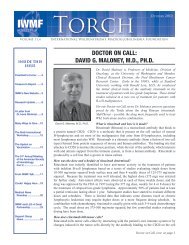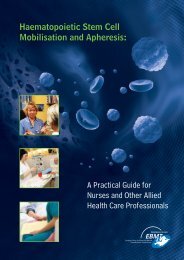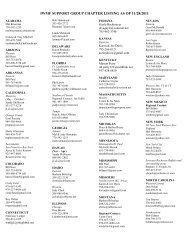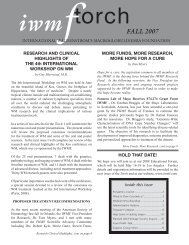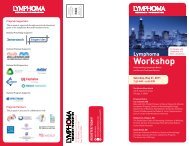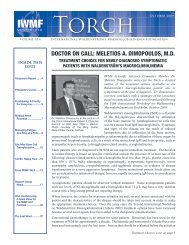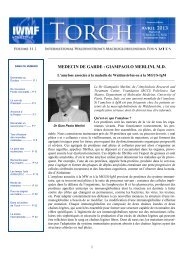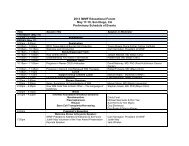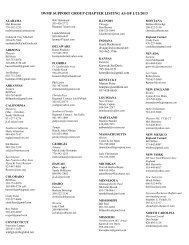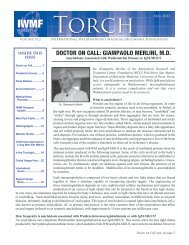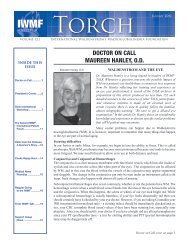English - International Waldenstrom's Macroglobulinemia Foundation
English - International Waldenstrom's Macroglobulinemia Foundation
English - International Waldenstrom's Macroglobulinemia Foundation
You also want an ePaper? Increase the reach of your titles
YUMPU automatically turns print PDFs into web optimized ePapers that Google loves.
RESEARCH UPDATE: THE IMMUNE RESPONSE TO WM<br />
IMPLICATIONS FOR IMMUNOTHERAPY<br />
by Tom Myer s and Guy Sherwood, M.D.<br />
The Waldenstrom’s <strong>Macroglobulinemia</strong> <strong>Foundation</strong> of<br />
Canada, the Canadian branch of the IWMF, is proud to be<br />
the principal sponsor of an important research initiative<br />
led by Brad Nelson, Ph.D., of the Trev and Joyce Deeley<br />
Research Center in Victoria, British Columbia. The research<br />
project, recently approved by the IWMF Scientific Advisory<br />
Committee, outlines the very first step toward immune-based<br />
therapy for WM. Below Tom Myers, IWMF Vice President<br />
for Research, and Guy Sherwood, M.D., IWMF Trustee and<br />
member of the Research Committee, explain how the project<br />
directed by Dr. Nelson offers hope of eventual disease control<br />
in WM through immunotherapy.<br />
Waldenstrom’s macroglobulinemia (WM) is an indolent non-<br />
Hodgkin lymphoma cancer characterized by bone marrow<br />
infiltration of malignant B cells and the production of large<br />
amounts of serum IgM. Currently there is no known cure for<br />
the cancer, but recent results using immune based therapies<br />
for lymphomas give hope that a cure may be developed using<br />
this approach.<br />
Dr. Nelson and his fellow scientists at the Deeley Research<br />
Center are interested in the development of strategies that<br />
could be used for future immune-based treatments for WM.<br />
Their proposed study will evaluate the use of a vaccine<br />
targeting the WM cell idiotype (an idiotype is a unique<br />
rearranged mutated version of the surface immunoglobulin<br />
that is specific to all cells within a WM patient’s tumor –<br />
essentially an ID tag) together with multiple other recently<br />
discovered vaccine targets found only in lymphomaspecific<br />
mutations. A vaccine that targets multiple sites on<br />
a cancer cell will provide higher response rates and disease<br />
control compared to a vaccine that simply targets the tumor<br />
cell idiotype.<br />
Furthermore, Dr. Nelson and his team will evaluate the<br />
feasibility of combining vaccine-based therapy with adoptive<br />
T-cell therapy – a much-discussed topic at the recent 2009<br />
American Society of Hematology meeting in New Orleans.<br />
The scientists plan to isolate “tumor reactive T-cells,” cells<br />
that have demonstrated an affinity for WM cells bearing the<br />
idiotype targets as well as the other identified lymphomaspecific<br />
mutations from patients with WM. Such T-cells<br />
(usually not present in sufficient numbers in the typically<br />
immune-compromised WM patient) can be removed from the<br />
patient, expanded exponentially in vitro, and then re-infused<br />
into the patient in much greater numbers with the expectation<br />
that they will eliminate all residual tumor cells. Such high<br />
concentrations of T-cells cannot always develop normally in<br />
a patient because of the cancer and its treatments. This will<br />
be the first study to investigate the immune response as a<br />
potential therapeutic agent for vaccine and/or adoptive T-cell<br />
based therapy in WM.<br />
In summary, this project aims to: identify in a series of WM<br />
patients the unique tumor cell idiotype as well as the recently<br />
discovered multiple other lymphoma-cell specific mutations;<br />
identify and isolate a population of the reactive T-cells that<br />
recognizes the particular target(s); and finally assess these<br />
cells for reproducibility and growth, relevance for immunebased<br />
therapy, ease of functionality, and targeted cytotoxic<br />
potential.<br />
Dr. Nelson and his team are well respected in the field of<br />
immunology and the research they are embarking on has<br />
the potential to result in new and effective treatment for<br />
those afflicted with WM. On behalf of all members of<br />
the IWMF, we express our gratitude to the WMFC for so<br />
generously undertaking to support this important advance in<br />
WM research.<br />
HIGHLIGHTS OF ASH 2009<br />
by Guy Sherwood, M.D., IWMF Trustee<br />
The fifty-first Annual Meeting of the American Society of<br />
Hematology (ASH) was held on December 5-8, 2009, in New<br />
Orleans, Louisiana. Attending physicians, researchers, and<br />
associated industry and cancer-organization related personnel<br />
were estimated to number at least 23,000. The IWMF had an<br />
information booth, and Tom Myers, Bill and Connie Paul,<br />
Sara McKinnie, and myself also attended to represent our<br />
<strong>Foundation</strong> and staff the booth.<br />
This article outlines my personal highlights of the ASH<br />
Annual Meeting, a summary of information that struck me as<br />
most important from all the lectures and posters I managed<br />
to hear and see during the four intense days of ASH. In<br />
upcoming issues of the Torch I will write about specific talks<br />
and reports that have particular importance to WM’ers.<br />
A series of presentations regarding the manipulation of the<br />
individual immune system was perhaps the most important<br />
Highlights of ASH 2009, cont. on page 8<br />
IWMF TORCH Volume 11.2<br />
7



